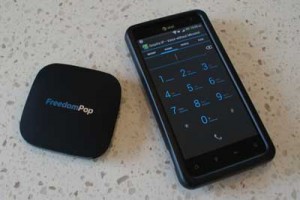I’ve been working hard to reduce my cell phone bill. Here’s the latest
It was way back in July when I last talked about my attempts to reduce my cell phone bill. If you’re looking for ways to bring down your monthly costs and are still dealing with an overpriced monthly contract plan, it may be an interesting read for you.
Back then I had begun testing a VERY low-cost cell phone structure, combining a Freedom Spot Photon 4G Mobile Hotspot with very low-cost prepaid (but auto-renewing) cell service from AirVoice. Total cost: $10/month. The trick is to move your main number to Google Voice and use the AirVoice number only for emergencies.
I’ve done quite a bit research since then on possible low-cost cell phone options and tried to keep track along the way. The results of my search for ways to reduce my cell phone bill are below, if you want to just jump ahead.
But first the update on my FreedomPop+AirVoice super cheap solution. The positives were that I could keep my same phone, which I was happy with, the low cost and the fact that I had no contract. Not being under a contract left me free to easily test without being committed to two years stuck with one carrier.
The negatives were that I had to pack a separate piece of electronics around all the time (not that big of a deal), and that the FreedomPop’s coverage was extremely limited (much bigger deal). Basically it gets a nice, strong signal in the main city, but anytime you leave the heavily populated areas, say 15 miles from downtown in any direction, it completely loses its signal. That actually became something a big pain any time we took a road trip. (One additional pain was that I got a lot of spam calls via the AirVoice number, which I found odd.)
So while I got used to the hassles of this set up and didn’t even think much about it after a while, I began to consider my next test. There is a bit of a price war going on right now so real prices for cell phone service have been dropping rapidly, just as I predicted they would. So it’s pretty easy to find a solution for around $30 these days. But I wanted to save even more!
Giving Ting a try
My latest attempt at reducing my cell phone bill was to sign up with Ting. I canceled my AirVoice plan (I still use the FreedomPop from time-to-time as it has more utility for me than just supporting my cell phone.)
Ting has one of the most interesting models for reducing cell phone costs that I’ve so far found. I highly recommend trying it to just about anyone because it’s very likely they could save you a lot of money right away.
The way Ting works is they bucket your actual usage and charge you for what you actually used. Duh! Why has no one done this before? If you check out their Rates page, you can click the various boxes in their grid and the page will compute what your bill would be.
I’ve been using them for two billing cycles now and both bills were less than $12! That’s pretty sweet, given that I’m willing to pay up to $30/month if needed. And, remember, this is a no-contract carrier, so anytime I decide I’m unhappy, I can walk.
I did have to buy another phone because Ting uses Sprint’s network and my old phone was an AT&T phone. I picked up a used one for $120 — about what I can get for my old phone. I haven’t sold my AT&T phone yet, just in case I decide to try something else. So right now I own a Sprint phone and an AT&T phone.
Google Voice is still the backbone
It’s important to keep in mind that keeping my cell phone costs so low is only possible because I use Google Voice as the carrier for my main phone number. All my texting and most of my calls are done via Google Voice. The only data I use via Ting is when I can’t reach my home or other WiFi, which given that I’m home most of the time is rare.
Google Voice works pretty well for the most part. I love the transcribed voice mails and it’s very handy to “move your phone” by simply logging on elsewhere.
Phone conversations are sometimes choppy and there is that annoying slight delay that causes the two people to occasionally talk over each other. But, hey, it’s free, right?
You can read up more on how Google Voice works in my last post.
You get what you pay for
So this solution is not without its hassles. I’ve experienced delays in sending and receiving text messages, calls via Google Voice where the other party is very frustrated they can’t hear me (they say I’m “breaking up”). Calls were much more reliable before I got this Sprint-based phone to use with Ting. With everything else being the same — same WiFi, same App, same location — the call quality was much worse with my Samsung Galaxy SII than my HTC Vivid. I believe that this is because the WiFi receiver is not as powerful in the Galaxy.
Frustratingly when on a recent call with a consulting client, I had to give up on Google Voice and call her via my Ting line. She said it sounded MUCH better — and then that call dropped. Embarrassing! (Note that I’m not necessarily saying Ting is lacking because of this. We live on the back of a hill and always have weak cell phone signals here.)
So I’m still testing. I can deal with a little bit lower quality, but I do need reliability. I don’t talk on the phone very much but when I need to, it had better be there.
The app world is still pretty shaky
I have found a lot of difference between the various apps that exist to support Google Voice. There are three that I’ve tried: TalkaTone, GrooveIP and Spare Phone. TalkaTone was godawful. I suppose I should try it again, but my experience was so bad I cringe thinking about it. For quite a while GooveIP was great, although I was hoping for some software updates to correct some problems in maintaining a connection to Google Voice. They actually did improve that massively in a few later updates, but unfortunately they also seem to have screwed up the call quality. Just a few days I dropped that to try Spare Phone. Spare Phone is a much simpler app and has been working pretty well lately. It’s still too early to make a final judgment, but I like it so far. My only complaint is some scratchy call quality on my end. People I’ve talked to haven’t complained yet, so time will tell.
Other ways to reduce my cell phone bill
While it has some great benefits, using Google Voice is a fairly extreme way to drop your cell phone costs. By channeling the majority of your calls and texts through Google, you can greatly bring your costs down if you choose a low-cost cell phone.
There are some other ways to go, though. A few honorable mentions from my research.
- Red Pocket Mobile
Red Pocket Mobileoffers coverage on both GSM and CDMA networks so this could save you from having to buy a new phone if you want to test out a low-cost cell phone carrier.
- Republic Wireless
While I’m a huge fan of the Ting business model, the Republic Wireless model is probably my second favorite. Republic works by utilizing WiFi for its calling the majority of the time and then uses a cellular network when WiFi is unavailable. They cleverly switch seamlessly (UPDATE: Maybe not seamlessly — see comments) back and forth between the two networks so you don’t notice the switch. Thus they’re able to keep their monthly prices low — $25 for a standard plan. The big negative, of course, is that you have to use their proprietary phones to make this work. That means buying another phone for as much as $300. Assume you’ll keep your phone for two years and convert that to a monthly price and that’s another $12.50/month. So you’d basically be back to $37.50/month, which is no longer one of the cheaper options. If you can be disciplined and keep your phone for four years, that’d effectively put you at $31.25, but, again, that’s basically the same as many of the carriers below. If I could get a Republic Wireless phone cheaper, I’d be all over this. But if you need to buy a new smartphone anyway, this could be a good option for you. - FreedomPop
FreedomPop is really shaking things up in the industry by taking the price right to zero. Free data, Free texts and free voice — all of which are very limited — could be just the ticket for a light user. Based on my mobile internet experience, however, I’d be very worried about the coverage map. Hopefully this spreads and helps bring down the cost for the entire industry.
These days there are many ways to reduce my cell phone bill so I don’t think I’ll ever need to pay more than around $30/month. I’ve been lower than $12 for around six months or so and while I can’t say it’s completely bulletproof, at this price I can handle some hiccups.
Here is a table I put together based on my research of low-cost providers. Take a look, explore. Your mileage may vary, but as long as you stay away from any long-term contracts, you can test a few different options until you find a good fit for your situation:
Lowering my cell phone bill: No-contract cell phone options
| Carrier | Talk | Text | Data | Pricing | Notes |
|---|---|---|---|---|---|
| Ting | Varies | Varies | Varies | Varies | I love the Ting model -- a true pay for what you use structure. |
| FreedomPop | 200 minutes | 500 | 500MB | Free! (If you stay under their usage limits) | Check the FreedomPop web site for details on their free phone plan. The Freedom Spot Mobile Hotspot |
| Republic Wireless | Unlimited | Unlimited | Unlimited | $25/month (3G) | Republic Wireless has a unique offering heavily utilizing WiFi to enable calling. Based on the network speed desired, Republic has plans higher and lower than shown here. |
| AirVoice Wireless | Unlimited | Unlimited | 100MB | $30/month | Also check out their other plans. There are quite a few viable options available for low cost. |
| ChitChat Mobile | 250 minutes | Unlimited | 250MB | $20/month | ChitChat offers mix-and-match style pricing. Take a look at what you need and see if one of their plans would work for you. |
| Simple Mobile | Unlimited | Unlimited | Unlimited | $25/month | |
| Consumer Cellular | 200 minutes | 1000 | 100MB | $25/month | Consumer Cellular is oriented toward the senior market. Many mix and match options to choose from. |
| I-Wireless | 200 minutes | Unlimited | 200MB | $25/month | Owned by grocery chain Kroger. |
| T-Mobile Prepaid | 100 minutes | Unlimited | Unlimited | $30/month | |
| TracFone Wireless | 200 minutes | Included | Included | $30/month | Several plans offer triple minutes with phone purchase. They also offer some pay as you go plans. Many of their offerings include bonuses in minutes and texts. It may be worth investigating their options if you think they might work for you. |
| Straight Talk Wireless | 1000 minutes | 1000 | Unlimited | $30/month | |
| H2O Wireless | Unlimited | Unlimited | 500MB | $30/month | |
| Virgin Mobile | 300 minutes | Unlimited | Unlimited | $35/month | |
| Go Smart Mobile | Unlimited | Unlimited | Unlimited | $35/month | |
| Net 10 Wireless | Unlimited | Unlimited | Up to 500MB | $40/month | |
| MetroPCS | Unlimited | Unlimited | Unlimited | $40/month | Owned by T-Mobile |
| GoPhone | 500 minutes | Unlimited | 200 MB | $40/month | Additional data can be added to this plan for $5/MB. They also have other plans available. |
| PTEL Mobile | Unlimited | Unlimited | Unlimited | $40/month | A $35 plan is also available without high speed internet. |
| Cricket | Unlimited | Unlimited | Unlimited | $50/month | |
| Boost Mobile | Unlimited | Unlimited | Unlimited | $55/month | Boost also offers a gimmick where you can drop your bill by paying on time. |
| AIO Wireless | Unlimited | Unlimited | Unlimited | $55/month | Owned by AT&T |
| Verizon Wireless Prepaid | Unlimited | Unlimited | 2GB | $60/month | |
| Red Pocket Mobile | Unlimited | Unlimited | 100MB | $30/month | Also has a basic $10/month plan. Red Pocket offers both CDMA and GSM so you may be able to bring your existing phone regardless of your current carrier. |
Prices and details shown here are subject to change. Some links include affiliate links so I may get a few cents if you make a purchase.
How much are you guys paying for cell phone service these day? What service are you using to keep cell phone costs low?



